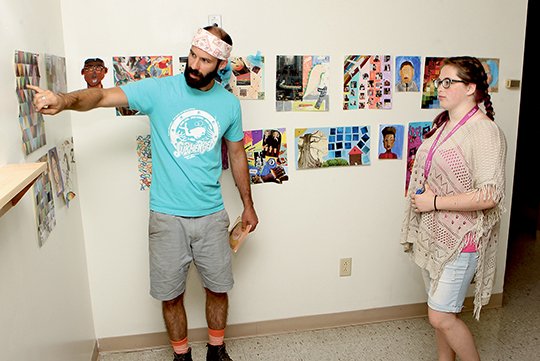The Arkansas School for Mathematics, Sciences and the Arts will conclude its two-week residential camp today for rising sophomores from across the state.
The school was one of six out of more than 100 of the nation's selective admissions public high schools selected for grant funds last year from the Jack Kent Cooke Foundation. Grants were awarded to increase access and success for low-income students at top high schools.
ASMSA received $61,152 for both summers of the camp, Helping Elevate Low-Income students to Excellence, known as Project HELIX. More than 30 students attended the camp each year. The grant funds are used for teacher pay, student support, meals, instructional materials and free ACT tests for students in November.
High school sophomores can begin the application process for ASMSA in the fall. Shaelyn Chestnut, of Western Yell County, said she is interested in the academic challenges ASMSA offers.
"I found the program and I decided I needed to come and feel out if I really wanted to go to this school or not," Chestnut said.
The camp is meant to allow students from rural and underserved communities, specifically those who qualify for free and reduced lunches, to interact directly with the school campus and its faculty. Malik Barnes, of West Memphis, said he was most impressed by the faculty.
"I was actually pretty amazed that everybody here has a master's and a Ph.D., but they still have that teaching style like a regular teacher," Barnes said. "It's pretty cool."
Lakeside student Madelynn Hickey said she is interested in attending ASMSA. Barnes and Hickey also said they are drawn to ASMSA's challenges.
"Coming here, I have actually found more people that are like me," Hickey said.
About 34 percent of the incoming juniors at ASMSA qualify for free and reduced lunches. Corey Alderdice said the national average for students on free and reduced lunches at ASMSA's peer institutions is about 15 percent.
"It maintains our institutional commitment to providing access for low income students," Alderdice said.
Eight participants from the inaugural Project HELIX camp last summer were accepted into ASMSA, in line with the school's projections. About half of the original cohort were expected to apply and half of those who applied were accepted.
The camp runs concurrently on campus with ASMSA's College Algebra Readiness Camp for more than 30 rising juniors who will begin at the school next month. Alderdice said the programs allow students to develop connections between their peer groups and learn about the school with each other.
"So HELIX wasn't just a clever acronym, but it was the idea of these two groups on campus interacting together" Alderdice said.
"I have enjoyed interacting with different people that I can relate to," Hickey said.
Courses were developed with broader concepts instead of specific content areas. Students were enrolled this week in Design Thinking, taught by Brad Wreyford, art instructor and Arts coordinator; Problem Solving, taught by math instructor Caleb Grisham; Problem Solving, taught by math instructor Denise Gregory; and Leadership Development, taught by Bob Gregory, dean of academic affairs.
"I really do like the fact that I am learning in a different kind of way than I learn typically in schools," Chestnut said. "For math, I am learning how to encrypt and decrypt codes and that's typically not something you would do in math."
Two of the four 90-minute sessions each day are held in the morning and the other two take place in the afternoon after lunch. Extra activities and meals have been provided each evening. Barnes said he plans to share with others how much he has enjoyed the camp.
"I'll tell them ASMSA is a great school," Barnes said. "The teachers are cool. The people here are cool. It's just a fun and loving environment to be in."
Alderdice said the grant was always planned as a pilot stage grant with no expectation of continued funding. He said the school must now determine how the program fits into its portfolio of admissions activities to connect with prospective students.
"We know that summer is an important piece," Alderdice said. "We know that spending time and introducing sophomores to it is important. And again, the institution has a long-standing commitment to both access and success for low-income students.
"Knowing those three factors, I feel good about us continuing HELIX. I think the question is, how does it fit into the portfolio and what is its evolution?"
Alderdice said ASMSA's usual practice is to test new programs in two-year cycles and determine if they are sustainable. He said most projects develop into long-term programs.
The school may look to align all of the summer programs into a shorter time frame. The residential Summer Arts Bridge camps were held on campus in June.
Alderdice said a one-week camp will likely suffice for possible future Project HELIX camps. He said the summer programs help students learn about the school and adjust to the campus.
"What we certainly know is that an immersive, summer experience targeted at sophomores is a great first step to getting students excited about enrolling at ASMSA and well-informed about what life and learning is like here," Alderdice said.
Local on 07/22/2016